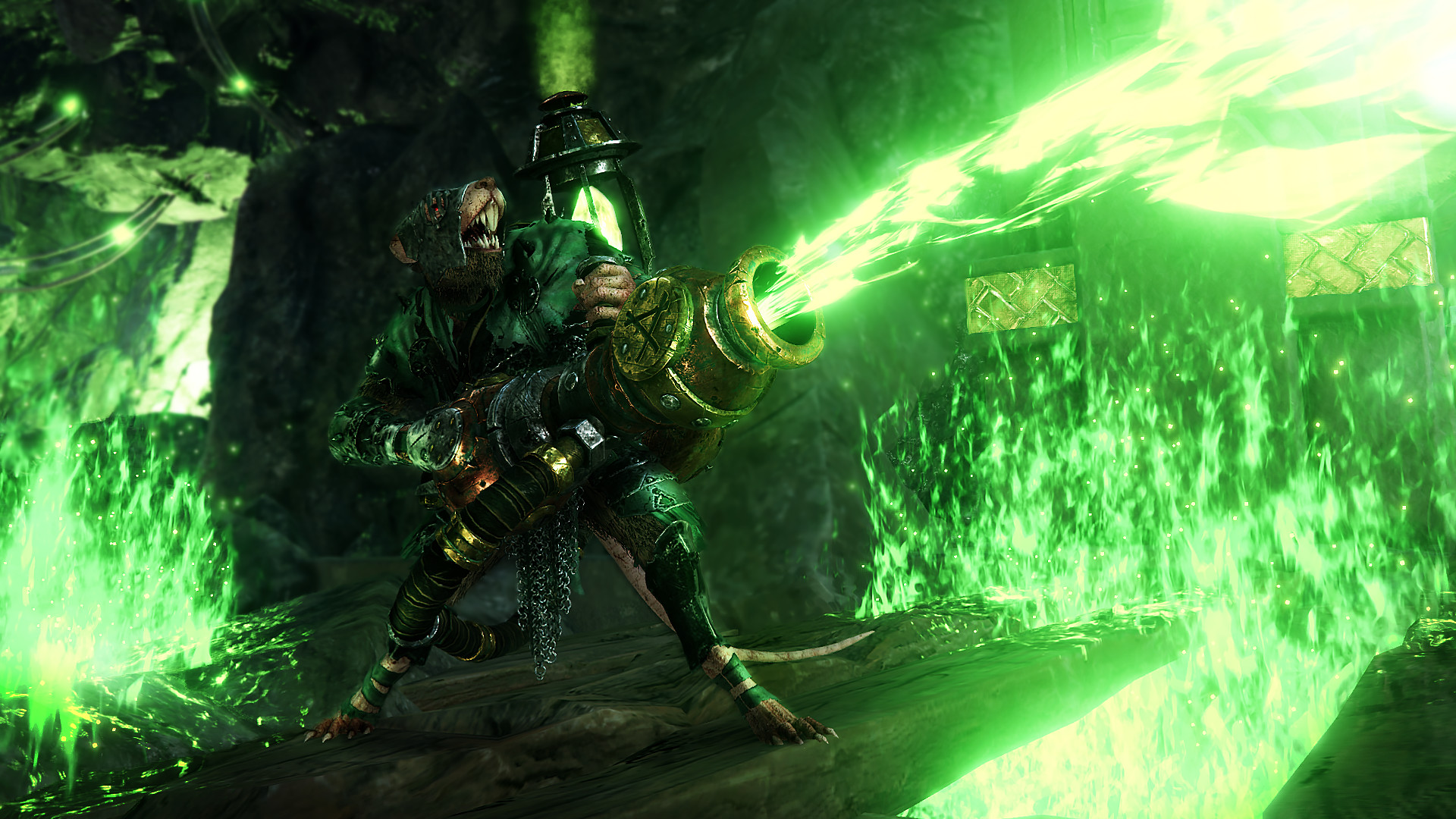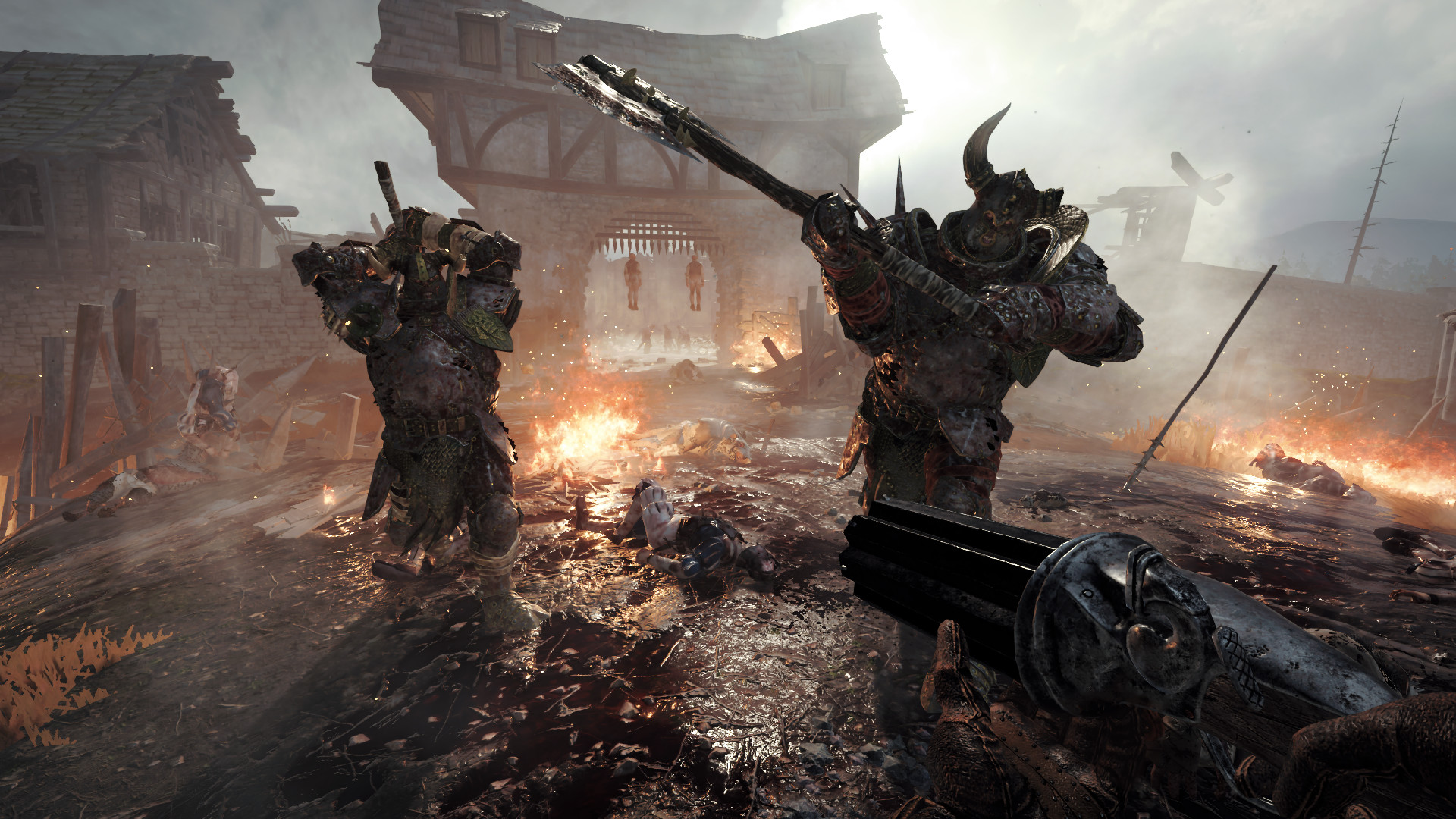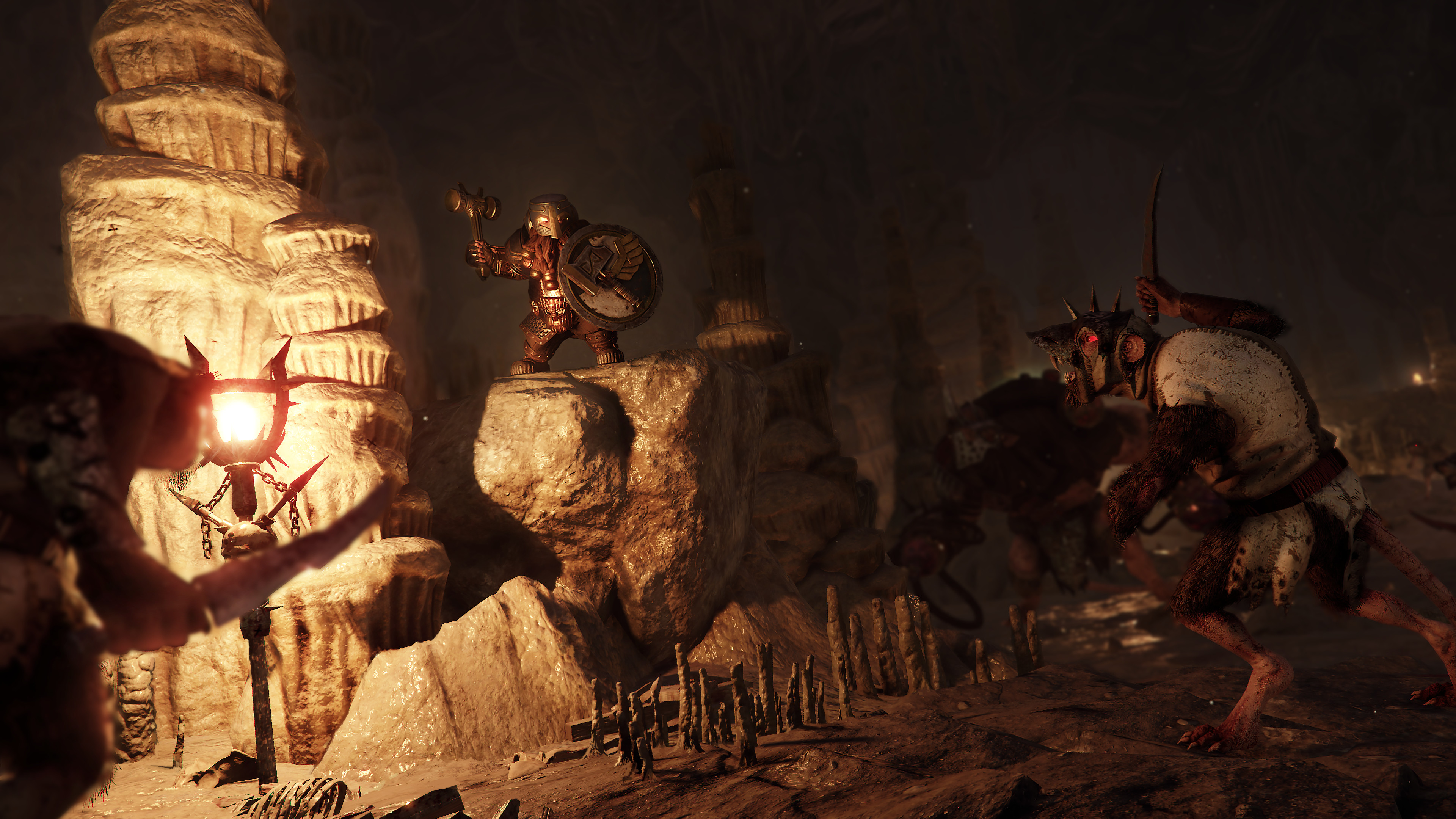With new enemies, new loot and mod support, Warhammer: Vermintide 2 is your next big co-op game
The rats are back, and they brought some ugly new friends.

This article was originally published in PC Gamer issue 313. For more quality articles about all things PC gaming, you can subscribe now in the UK and the US.
In the Warhammer universe there are few sights more heroic than that of a screaming dwarf being repeatedly slammed against the floor by the tentacle of a rampaging Chaos Spawn. I used this distraction to slip behind the mutant and stab it repeatedly in the back with my spear—a classic elfish move. In its surprise, the Chaos Spawn lets go of the dwarf, who screams and starts battering the creature with his axe, completely unfazed by what just happened.
The Chaos Spawn is one of Vermintide 2’s new bosses. It towers over the Rat Ogre—previously the biggest special enemy—and is just one of the terrors the new Chaos faction brings to the series. The sequel stays true to the first game’s take on the Left 4 Dead format: you play as one of a team of four heroes fighting through gauntlets populated by hordes mustered by an AI director. The first game surprised us with its satisfying first-person melee combat, cool loot and a good understanding of what makes the Warhammer fantasy world grim and hilarious. The sequel is building on that with more environments, enemies, class options and a revamped loot system. However, the first thing I notice is how good the weapons feel. The bounty hunter Victor sends enemies flying with his warhammer, and you can smash half a dozen bodies with one power swing if you hold down left-click for a few seconds. The elf’s spear lashes out spitefully at greater speed and does bonus damage when you poke an enemy in the back.
“The thing that really makes it feel chunky and really nice is the combination of effect, sound and also the stagger animations on the enemies you hit,” says lead designer Victor Magnuson. “That’s where the real impact comes from. We’ve increased a lot of the dismemberment stuff we had, so we can do it lots of different ways this time round.” Headshots with the hammer show off the new system in all its gory magnificence. The headless enemy stumbles around waving his arms wildly for a few moments before finally collapsing—it’s gross, but undeniably funny. In addition to melee weapons, most characters have a ranged option, including rapid-fire crossbows and blunderbusses, and new weapons are doled out in loot chests you find at the end of each round.
Vermintide II will feature 13 missions divided into mini-arcs that culminate in a battle with a ‘Lord’. These massive bastards will battle you in bespoke arenas and they’re even more powerful than the Chaos Spawn and Rat Ogres, who can invade your game at the AI director’s discretion. Lords include a Chaos sorcerer called Halescourge, a Skaven Chieftain called Skarrik Spinemanglr, and a Chaos champion called Bödvarr Ribspreader. In each arc you follow a Lord’s trail of destruction on the path to a final showdown.

The campaign’s greater scope means levels are mostly set beyond the dark confines of the original Vermintide’s city, in sacked cities and magic forests. The levels are static, but there are multiple routes and a good mix of claustrophobic tunnels and ruins and open areas. The demo mission I played started in some fields and took me into a town that was overrun by Chaos. Some of the screenshots look bright and sunny, but the tone is suitably apocalyptic. Developer Fatshark is serious about using Vermintide to show the End Times—the apocalypse that Games Workshop used a few years ago to blow up the Warhammer universe they spent three decades building.
Chaos Warriors are hulking, armoured enemies. Bullets and crossbow bolts bounce off them, but strikes to their rear armour will get through while keeping you away from their huge weapons.
It wouldn’t be the end of the world without some Chaos hordes. Rabid human marauders are this faction’s fodder. These shirtless wonders love to charge in with an axe in each hand, screaming wordlessly as you lop off their limbs and heads with wide, thrashing swings or the wide blast of a blunderbuss. Both the Chaos and Skaven warriors have many variations in Vermintide 2. Enemies with shields are good at fending off certain weapons, while special variants like Plague Monks explode in a cloud of noxious gas on death. The new faction has its own heroes, too. Chaos Warriors are hulking, armoured enemies. Bullets and crossbow bolts bounce off them, but strikes to their rear armour will get through while keeping you away from their huge weapons. The size and durability of the Chaos enemies is a good contrast to the fragile Skaven.
Keep up to date with the most important stories and the best deals, as picked by the PC Gamer team.
It’s quite possible to find yourself fighting both factions at the same time, though the AI director has been tuned to populate levels in ‘chunks’ that decide which faction will turn up in a given area. Of course, you’ll always find hordes of rats in Skaven lairs, and you’re more likely to run into Chaos in pillaged towns, but the AI director is free to extensively remix each level. Often enemies will attack in waves, flooding into the area through hidden doorways and side alleys, but sometimes you will encounter them tramping around the streets on marching orders. Sometimes they’re heading off somewhere else, sometimes they patrol right into your fight to add to the chaos. Fatshark wants players to see the enemies as an occupying force on a mission, not just a bogeyman the AI director can summon out of nowhere. In addition to these new patrol behaviours, the sheer variety of enemy types and minibosses should greatly extend Vermintide 2’s shelf life.
“In Vermintide if you’ve played one level chances are you’ve seen all the enemies,” says Magnuson. Fatshark CEO Martin Wahlund agrees, adding, “we needed everything. Now when you play you can play a couple of levels and you haven’t faced all of them. You can probably play eight or nine levels and something new pops up.”

Chaos and Skaven don’t fight one another, but their attacks can hurt everyone. Cornered in a ruin by a horde of marauders, I was saved by a spume of lime-green gloop, fired through a doorway by a Skaven Warpfire Thrower. The fizzing spunk thinned out the marauders and gave me the space to fight out of the room and bash the Warpfire Thrower down some stairs. Vermintide is gory, slapstick and chaotic in a way that’s especially entertaining in co-op. Later I teamed up with some developers and merrily smashed up a whole army of rats in a forest—an example of some of the more open environments we can expect from many of Vermintide 2’s levels. I dedicated myself to swatting aside the Gutter Runner assassins that kept jumping us from the undergrowth.
There are five heroes to choose from, which map onto similar archetypes to the first game. This time, however, each character has three ‘careers’, which determine their passive abilities, super abilities and talent trees. When you level up with a character you gain power and points to put into these talent trees. The sneaky elf fighter Kerillian’s Shade career gives her a passive ability that increases damage dealt from behind and an active super ability that lets her stealth through enemies in the middle of a fight. The dwarf Bardin has Slayer, Ironbreaker and Ranger careers that let him specialise in damage, resilience and ranged effectiveness respectively. The soldier Victor Saltzpyre can be a melee-focused Bounty Hunter, a gun-loving Witch Hunter Captain or a Zealot, who is responsible for the addition of flails to Vermintide 2’s arsenal. I’m looking forward to finding out what the pyromaniac Bright Wizard Sienna’s careers will be: fire, fire… and more fire?
The careers system is flexible, so you can switch between careers and apply talent points at will. Talents can skew your chosen career towards a playstyle you like. If you want to go all-in on backstabbing with Kerillian you’ll find talents that support that in the Shade career. The new system is part of a broader attempt to give Vermintide 2 a better progression system than the first game. “We had levels in Vermintide, but they didn’t actually do anything,” says Magnuson. “It was just a number that told you how much you played. People were running around at level 1,000 and all that really says is that he’s played a lot.
“This time around we have a real levelling system where you get talent points and you also get a power increase each time you level up. It won’t be the end-all, the skill is still the most important part of the game.”

The loot system has been completely overhauled. Weapons will drop with traits that grant them particular effects, but they will also provide other benefits. “So a weapon can change your stats, give you more health or make you better at blocking and dodging,” says Magnuson. Loot will help your character develop up to a point, but expect Vermintide 2’s toughest challenges to yield more cosmetic items like skins for your heroes. “It’s an important part of the philosophy of items and grind in the game. Items and levelling up will only take you this far, then the real challenge starts and we’re not going to mess with that. We’re not going to let you grind that away.”
Fatshark is planning to incorporate Steam Workshop support for Vermintide 2, though it will take some steps to separate modded games from standard games to protect the integrity of the loot system.
In addition to the campaign missions, Vermintide 2 will give you contracts as special loot drops. These are quirky one-off challenges that come with some tasty rewards and it’s one of the key tools Fatshark can use to keep the game fresh for regular players. “It lets us do almost whatever we want because it’s a one-off thing,” says Wahlund. “It could be a level you have to play solo. It could be a really hard challenge. If you do it you will get a really cool reward and be able to show off.”
“We haven’t done this yet, but in theory we could make a level that’s more like a Gone Home-type experience,” explains Magnuson. “There is actually no challenge at all. You get this contract and you go in and walk around in the level and just pick up stuff, it opens up that type of thing that we could actually do. If we put that in the main game it would completely ruin the game, but the system allows us to go that far. You do this and you are done, and you get a hat.”
Fatshark also wants to embrace mods for its sequel. It didn’t officially support mods in the original Vermintide, but that didn’t stop players from creating them. This time Fatshark is planning to incorporate Steam Workshop support for Vermintide 2, though it will take some steps to separate modded games from standard games to protect the integrity of the loot system. It’s a tough balance, but Fatshark plans to choose the best community mods and incorporate them into the main game. Magnuson lists “UI changes and game modes” as examples of the sort of mods that might receive official approval.

Mods are another great way to encourage replayablility, and they are a way for the community to tell the developers what they want from the game. Many of Vermintide 2’s changes are designed to put an official stamp on activities that players invented for themselves in Vermintide. Skilled players would take on the toughest levels in the game solo, just for kicks, now with contract missions and mods Vermintide 2 is able to reward those players and give them a way to create more challenges.
The most puzzling thing about Vermintide is that there aren’t more games like it. The Left 4 Dead format has so much untapped potential it’s about time a studio came along and built on it. Fatshark is also surprised that more games haven’t tried to build on Valve’s foundations, though it suggests the difficulties of designing an AI director offers some insight as to why. Nonetheless, it’s satisfying to watch Vermintide 2 build something new out of the format. Left 4 Dead was in part a love letter to zombie movies and schlock horror. The Warhammer setting, batshit as it is, offers more scope. It makes sense to have glittering loot and RPG mechanics in a universe born out of tabletop wargaming and pen and paper traditions.
The wide range of enemies, minibosses and Lords is a transformative change. The original Vermintide became rote once you learned every enemy’s behaviours and the dark city environments were limiting after a while. Fatshark is even using the sequel to rethink the climactic last stand sections at the end of each level. After we fought through the forest and a Skaven lair, we battled our way into some High Elf ruins, complete with all that floating stonework that all magical ruins have. One by one we had to activate glyphs to unlock the temple as rats poured in. I used Victor’s charge power on a narrow ramp to send Skaven flying to their deaths, to cheers from my teammates. Then I got to work with my hammer once more. There’s always another rat to splat in Vermintide 2, and I can see myself doing this for hundreds of hours when the game comes out this year. Bring on the hordes.
Part of the UK team, Tom was with PC Gamer at the very beginning of the website's launch—first as a news writer, and then as online editor until his departure in 2020. His specialties are strategy games, action RPGs, hack ‘n slash games, digital card games… basically anything that he can fit on a hard drive. His final boss form is Deckard Cain.


